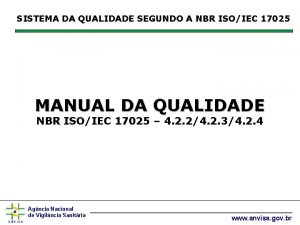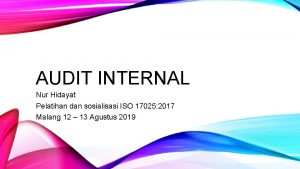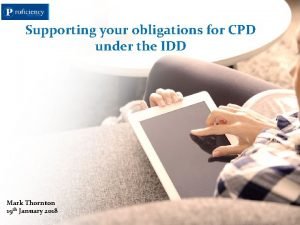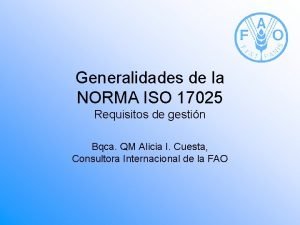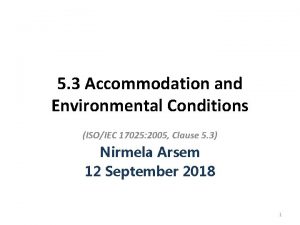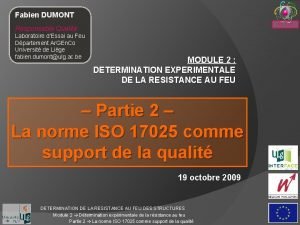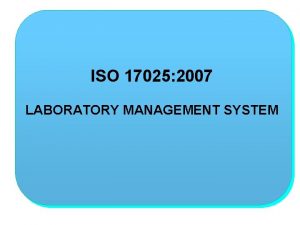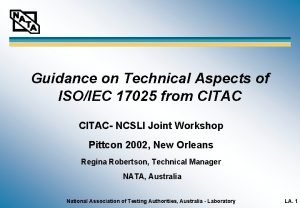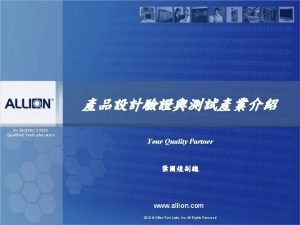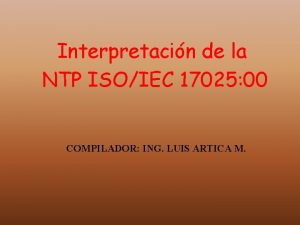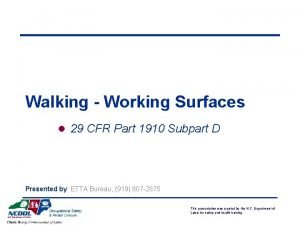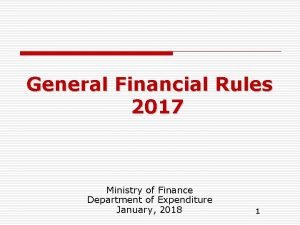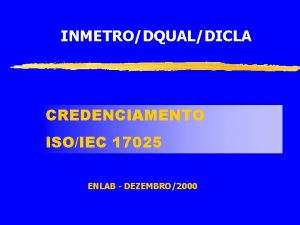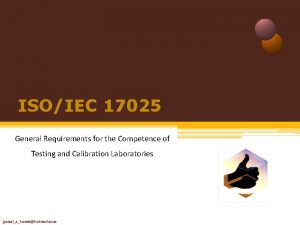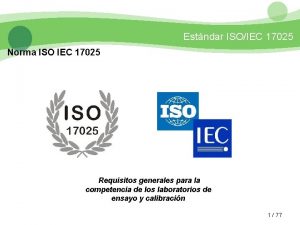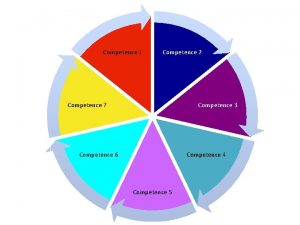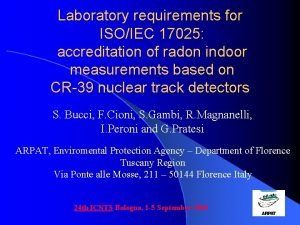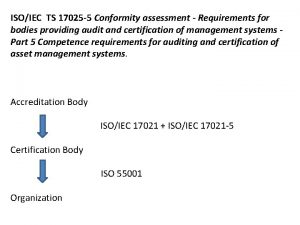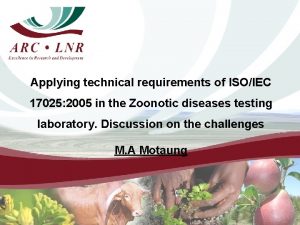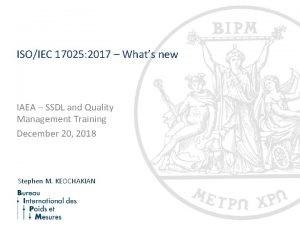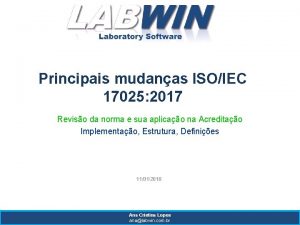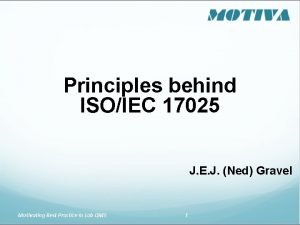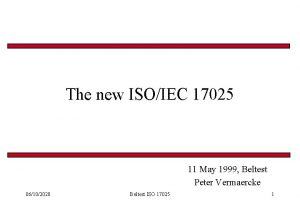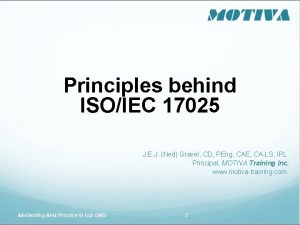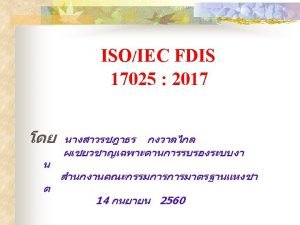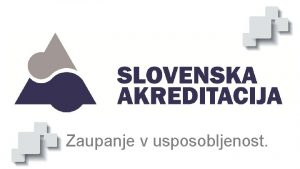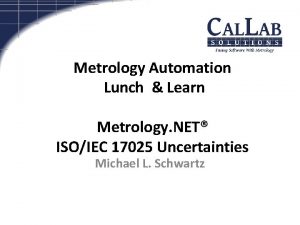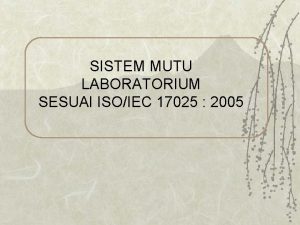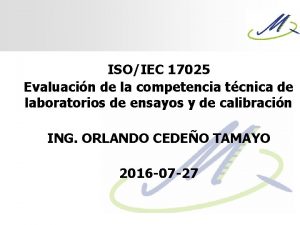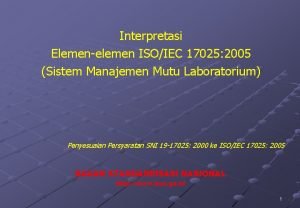ISOIEC 17025 2017 General requirements for the competence














![3 Terms and definitions [new or modified] 3. 4 intralaboratory comparison organization, performance and 3 Terms and definitions [new or modified] 3. 4 intralaboratory comparison organization, performance and](https://slidetodoc.com/presentation_image_h/da371c59fe92e050b6f29b2c99df2009/image-15.jpg)
![3 Terms and definitions [new or modified] 3. 5 proficiency testing evaluation of participant 3 Terms and definitions [new or modified] 3. 5 proficiency testing evaluation of participant](https://slidetodoc.com/presentation_image_h/da371c59fe92e050b6f29b2c99df2009/image-16.jpg)
![3 Terms and definitions [new or modified] 3. 6 laboratory body that performs one 3 Terms and definitions [new or modified] 3. 6 laboratory body that performs one](https://slidetodoc.com/presentation_image_h/da371c59fe92e050b6f29b2c99df2009/image-17.jpg)
![3 Terms and definitions [new or modified] 3. 7 decision rule a rule that 3 Terms and definitions [new or modified] 3. 7 decision rule a rule that](https://slidetodoc.com/presentation_image_h/da371c59fe92e050b6f29b2c99df2009/image-18.jpg)































- Slides: 49

ISO/IEC 17025: 2017 General requirements for the competence of testing and calibration laboratories

Contents • • Revision process Objectives of revision Main changes Detailed review of changes and updates

Revision process

CASCO Working Group 44 Co-Convenors Nominating Member: Heribert Schorn International Electrotechnical Commission (IEC) Steve Sidney South African Bureau of Standards Warren Merkel International Laboratory Accreditation Cooperation (ILAC) ~150 experts • 129 Committee members • 21 Liaison members

Fifth meeting of Working Group 44 20 -23 September 2016 ISO Headquarters, Geneva

Revision timeline WG 44 meeting Oct 2014 Vote to revise ISO/IEC 17025 Feb 2015 WG 44 meeting June 2015 WG 44 meeting CD 1 CD 2 DIS FDIS Aug/Sept 2015 CD 1 Ballot Result: 80% Approval; 2, 606 comments Feb 2016 May 2016 CD 2 Ballot Result: 96% Approval; ~2, 100 comments Sep 2016 Dec 2016 DIS Ballot Result: 91% Approval; 9% Negative ~2, 000 comments Publication July Aug 2017 FDIS Ballot Result: 99% Approval; 1% Negative Nov 2017

Objectives of revision

Objectives of revision • Align structure and content with other recently revised ISO standards • CASCO QS-CAS-PROC/33, Common elements in ISO/CASCO Standards • Other CASCO toolbox standards • ISO 9001: 2015 • Focus on outcomes rather than prescriptive requirements • Update language to reflect current practices and technologies • Retain language from 2005 version whenever possible

Main changes

Main changes From the Foreword of ISO/IEC 17025: 2017: – the risk-based thinking applied in this edition has enabled some reduction in prescriptive requirements and their replacement by performance-based requirements; – there is greater flexibility than in the previous edition in the requirements for processes, procedures, documented information and organizational responsibilities; – a definition of “laboratory” has been added.

Main changes (2) • Scope of the standard: laboratory activities Ø Testing, calibration, sampling associated with subsequent testing • Defined range of activities for laboratory Ø Excludes externally provided laboratory activities on an ongoing basis • Emphasis on “Impartiality” vs. “Independence” • Process orientation • Information Technology: Risks, data integrity, confidentiality, validation of software, considering electronic documents • Metrological traceability • Decision Rules for statements of conformity (pass/fail)

Detailed review of changes and updates

New structure 1. Scope 2. Normative references 3. Terms and definitions 4. General requirements 5. Structural requirements 6. Resource requirements 7. Process requirements 8. Management requirements Annex A Metrological traceability Annex B Management system

1 Scope This document specifies the general requirements for the competence, impartiality and consistent operation of laboratories. This document is applicable to all organizations performing laboratory activities, regardless of the number of personnel. Laboratory customers, regulatory authorities, organizations and schemes using peer-assessment, accreditation bodies, and others use this document in confirming or recognizing the competence of laboratories.
![3 Terms and definitions new or modified 3 4 intralaboratory comparison organization performance and 3 Terms and definitions [new or modified] 3. 4 intralaboratory comparison organization, performance and](https://slidetodoc.com/presentation_image_h/da371c59fe92e050b6f29b2c99df2009/image-15.jpg)
3 Terms and definitions [new or modified] 3. 4 intralaboratory comparison organization, performance and evaluation of measurements or tests on the same or similar items, within the same laboratory (3. 6), in accordance with predetermined conditions [New, based on ISO/IEC 17043: 2010 definition for “interlaboratory comparison”, which is included as 3. 3 in ISO/IEC 17025: 2017]
![3 Terms and definitions new or modified 3 5 proficiency testing evaluation of participant 3 Terms and definitions [new or modified] 3. 5 proficiency testing evaluation of participant](https://slidetodoc.com/presentation_image_h/da371c59fe92e050b6f29b2c99df2009/image-16.jpg)
3 Terms and definitions [new or modified] 3. 5 proficiency testing evaluation of participant performance against pre-established criteria by means of interlaboratory comparisons (3. 3) [SOURCE: ISO/IEC 17043: 2010, 3. 7, modified — Notes to entry have been deleted. ]
![3 Terms and definitions new or modified 3 6 laboratory body that performs one 3 Terms and definitions [new or modified] 3. 6 laboratory body that performs one](https://slidetodoc.com/presentation_image_h/da371c59fe92e050b6f29b2c99df2009/image-17.jpg)
3 Terms and definitions [new or modified] 3. 6 laboratory body that performs one or more of the following activities: − calibration − testing − sampling, associated with subsequent calibration or testing Note 1 to entry: In the context of this document, “laboratory activities” refer to the three abovementioned activities.
![3 Terms and definitions new or modified 3 7 decision rule a rule that 3 Terms and definitions [new or modified] 3. 7 decision rule a rule that](https://slidetodoc.com/presentation_image_h/da371c59fe92e050b6f29b2c99df2009/image-18.jpg)
3 Terms and definitions [new or modified] 3. 7 decision rule a rule that describes how measurement uncertainty will be accounted for when stating conformity with a specified requirement

4 General requirements

4. 1 Impartiality • Language taken from CASCO Procedure document (consistent with other conformity assessment standards) • New/changed requirements: • Identifying and risks to impartiality on an on-going basis • Addressing risks to impartiality

4. 2 Confidentiality • Language taken from CASCO Procedure document (consistent with other conformity assessment standards) • New/changed requirements: • Stronger emphasis on customer awareness • More detail regarding specific cases where confidentiality could be affected

5 Structural requirements

5 Structural requirements • Removed terms “technical management” and “quality manager” • Retained same essential functions • Introduced requirement for laboratory to identify range of laboratory activities for which it conforms with ISO/IEC 17025 • Restricts claims of conformity to the defined range • Excludes externally provided laboratory activities on an ongoing basis

5 Structural requirements • 5. 5 c) requires laboratory to “document its procedures to the extent necessary to ensure the consistent application of its laboratory activities and the validity of the results. ” • Revised standard consistently uses term “procedure” when the intent is for laboratory to maintain documentation • The extend of detail in that documentation is up to the laboratory, subject to the conditions in 5. 5 c)

6 Resource requirements

6. 1 General “The laboratory shall have available the personnel, facilities, equipment, systems and support services necessary to perform its laboratory activities. ” • Use of the term “available” indicates an approach in the revision to focus less on the status or ownership of resources and more on the relevant requirements for those resources • Examples: • • • 6. 2. 1 refers to all personnel, internal or external [vs. 2005 version requiring personnel be employed by or under contract] 6. 4. 1 requires laboratory to have access to equipment [vs. 2005 version requiring laboratory be furnished with all items]

6. 2 Personnel • Terminology and requirements have been updated and reorganized in the revision • Otherwise, no significant changes to this clause compared to the 2005 version

6. 3 Facilities and environmental conditions • Terminology and requirements have been updated and reorganized in the revision • Otherwise, no significant changes to this clause compared to the 2005 version

6. 4 Equipment 6. 4. 1 The laboratory shall have access to equipment (including, but not limited to, measuring instruments, software, measurement standards, reference materials, reference data, reagents, consumables or auxiliary apparatus) that is required for the correct performance of laboratory activities and that can influence the results. • Description of items considered as equipment is more inclusive than in 2005 version • Notes provide more information regarding reference materials

6. 4 Equipment • 6. 4. 6 identifies two criteria that determine when calibration of equipment is requirement – the measurement accuracy or measurement uncertainty affects the validity of the reported results, or – calibration of the equipment is required to establish the metrological traceability of the reported result. • • These criteria apply for all laboratory activities [2005 version had different requirements for calibration and testing] Metrological traceability addressed in a separate clause (6. 5) [2005 version included calibration in the traceability clause]

6. 5 Metrological traceability • Terminology and requirements have been updated in the revision to reflect current practice in traceability • Reduced the number of Notes compared to 2005 version • Additional explanatory information included in Annex A

6. 6 Externally provided products and services • Combines 4. 5 Subcontracting and 4. 6 Purchasing services and supplies from 2005 version • In all cases, have requirements and controls • Focuses on communication with customer Supplies External services “Subcontracting” • Select • Control • Verify Competent Supplier

7 Process requirements

7. 1 Review of requests, tenders and contracts New/updated requirements • 7. 1. 3 requires statements of conformity and associated decision rules be addressed during contract review • 7. 1. 4 states that deviations requested by the customer shall not impact the integrity of the laboratory or the validity of the results

7. 2 Selection, verification and validation of methods • Terminology and organization of clause updated from 2005 version • Note after 7. 2. 1. 1 clarifies that “method” as used in this document can be considered synonymous with the term “measurement procedure” as defined in ISO/IEC Guide 99.

7. 3 Sampling • Definition of laboratory (3. 6) clarifies that the sampling activity is associated with subsequent testing or calibration • Otherwise, no significant changes to this clause compared to the 2005 version

7. 4 Handling of test or calibration items • 7. 4. 3 includes a new requirement: “When the customer requires the item to be tested or calibrated acknowledging a deviation from specified conditions, the laboratory shall include a disclaimer in the report indicating which results may be affected by the deviation. ” • Otherwise, no significant changes to this clause compared to the 2005 version

7. 5 Technical records • Technical records placed in this clause as process requirements • Other types of records (e. g. , management system records) addressed in Clause 8 • Otherwise, no significant changes to this clause compared to the 2005 version

7. 6 Evaluation of measurement uncertainty • 7. 6. 1 requires all laboratories to identify contributions to measurement uncertainty • 7. 6. 2 requires evaluation of measurement uncertainty for all calibrations, including those a laboratory performs on its own equipment (i. e. “in-house” calibrations) • 7. 6. 3 includes essentially the same requirements for evaluation of uncertainty for testing as the 2005 version • Note 2 applies to all laboratories, and clarifies that a laboratory is not required to calculate a unique uncertainty every time a test or calibration is performed provided the stated conditions are met

7. 7 Ensuring the validity of results • Clause separates requirements for monitoring done within the laboratory (7. 7. 1) and those involving comparison with other laboratories (7. 7. 2) • Data from internal activities (7. 7. 1) required to be recorded such that trends can be detected and, where practicable, statistical techniques applied • Both required to be planned and reviewed, analyzed, used to control and (if applicable) improve laboratory activities • Action required when results of analysis of data found to be outside pre-defined criteria

7. 8 Reporting of results • Language reflects current approaches to reporting • New/updated requirements • 7. 8. 2. 2 addresses data provided by a customer, including a disclaimer when those data can affect validity of results • 7. 8. 5 reporting sampling • 7. 8. 6 reporting statements of conformity

7. 9 Complaints • Language taken from CASCO Procedure document (consistent with other conformity assessment standards) • New/updated requirements • 7. 9. 2 requires a description of the complaints handling process be available to any interested party upon request • 7. 9. 6 requires the outcomes to be communicated to the complainant be made by, or reviewed and approved by, individual(s) not involved in the original laboratory activities in question

7. 10 Nonconforming work • No significant changes to this clause compared to the 2005 version

7. 11 Control of data and information management • Extends and updates 5. 4. 7 in the 2005 version to address current laboratory practice • 7. 11. 2 Note 1 clarifies that use of the term “laboratory information management system(s)” in this document includes both computerized and non-computerized systems • 7. 11. 4 requires laboratory to ensure that off-site or external providers of information management comply with applicable requirements of ISO/IEC 17025

8 Management system requirements

8. 1 Options • The revision now provides two distinct options (A or B) for establishing a management system • Option A: As a minimum the management system of the laboratory shall address the requirements in clauses 8. 2 to 8. 9 • Option B: Establish and maintain a management system in accordance with the requirements of ISO 9001 • Both options require that the management system is capable of supporting and demonstrating the consistent achievement of the requirements of ISO/IEC 17025 clauses 4 to 7 and assuring the quality of the laboratory results. • Laboratories need only conform to one of the options (not both)

8. 1 Options 8. 1. 2 Option A As a minimum the management system of the laboratory shall address the following: – management system documentation (see 8. 2) Similar to 2005 version – control of management system documents (see 8. 3) – control of records (see 8. 4) – actions to address risks and opportunities (see 8. 5) Aligned with ISO 9001: 2015 – improvement (see 8. 6) – corrective action (see 8. 7) – internal audits (see 8. 8) – management review (see 8. 9) New

8. 5 Actions to address risks and opportunities (Option A) • Revision incorporates “risked-based thinking” • Introduction and Note after 8. 5. 2 include two important points: • There is no requirement formal methods for risk management or a documented risk management process • The laboratory is responsible for deciding which risks and opportunities need to be addressed

Thank you For questions contact: casco@iso. org For additional resources visit the ISO page dedicated to ISO/IEC 17025.
 Isoiec
Isoiec Daftar pertanyaan audit internal iso 17025:2017
Daftar pertanyaan audit internal iso 17025:2017 Idd cpd requirements
Idd cpd requirements Requisitos de la norma iso 17025
Requisitos de la norma iso 17025 Iso 17025 environmental conditions
Iso 17025 environmental conditions Exemple pratique de la norme iso 17025
Exemple pratique de la norme iso 17025 Iso laboratory management system
Iso laboratory management system Ntp 17025
Ntp 17025 Ntp 17025
Ntp 17025 Ntp iso 17025
Ntp iso 17025 55 miller street
55 miller street Cfr part 1910
Cfr part 1910 Financial rules 2017
Financial rules 2017 Fspos
Fspos Typiska drag för en novell
Typiska drag för en novell Nationell inriktning för artificiell intelligens
Nationell inriktning för artificiell intelligens Vad står k.r.å.k.a.n för
Vad står k.r.å.k.a.n för Varför kallas perioden 1918-1939 för mellankrigstiden?
Varför kallas perioden 1918-1939 för mellankrigstiden? En lathund för arbete med kontinuitetshantering
En lathund för arbete med kontinuitetshantering Underlag för särskild löneskatt på pensionskostnader
Underlag för särskild löneskatt på pensionskostnader Tidbok för yrkesförare
Tidbok för yrkesförare Sura för anatom
Sura för anatom Densitet vatten
Densitet vatten Datorkunskap för nybörjare
Datorkunskap för nybörjare Stig kerman
Stig kerman Tes debattartikel
Tes debattartikel Delegerande ledarstil
Delegerande ledarstil Nyckelkompetenser för livslångt lärande
Nyckelkompetenser för livslångt lärande Påbyggnader för flakfordon
Påbyggnader för flakfordon Formel för lufttryck
Formel för lufttryck Publik sektor
Publik sektor Kyssande vind
Kyssande vind Presentera för publik crossboss
Presentera för publik crossboss Vad är ett minoritetsspråk
Vad är ett minoritetsspråk Vem räknas som jude
Vem räknas som jude Treserva lathund
Treserva lathund Epiteltyper
Epiteltyper Claes martinsson
Claes martinsson Cks
Cks Verifikationsplan
Verifikationsplan Mat för unga idrottare
Mat för unga idrottare Verktyg för automatisering av utbetalningar
Verktyg för automatisering av utbetalningar Rutin för avvikelsehantering
Rutin för avvikelsehantering Smärtskolan kunskap för livet
Smärtskolan kunskap för livet Ministerstyre för och nackdelar
Ministerstyre för och nackdelar Tack för att ni har lyssnat
Tack för att ni har lyssnat Hur ser ett referat ut
Hur ser ett referat ut Redogör för vad psykologi är
Redogör för vad psykologi är Stål för stötfångarsystem
Stål för stötfångarsystem Atmosfr
Atmosfr
